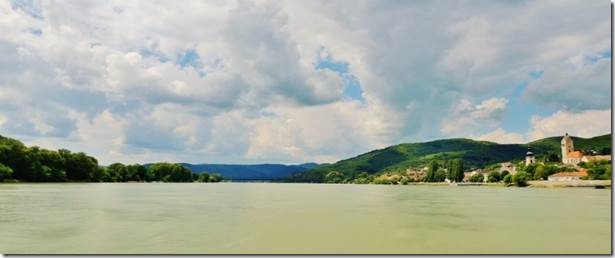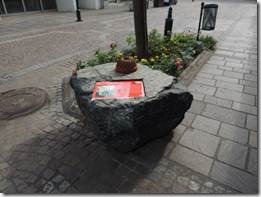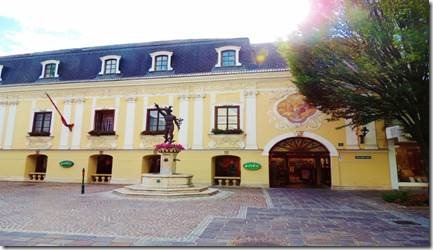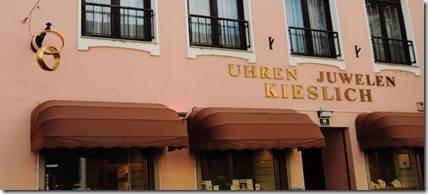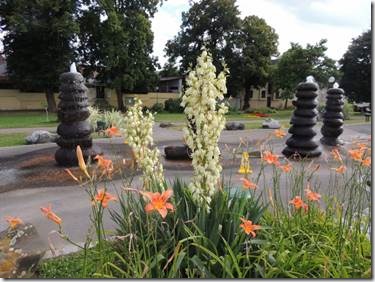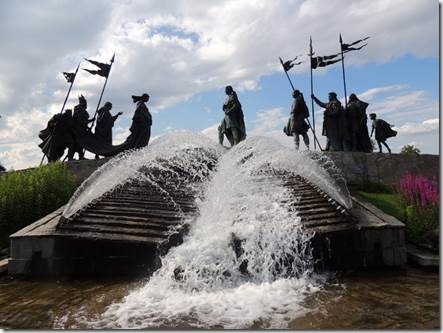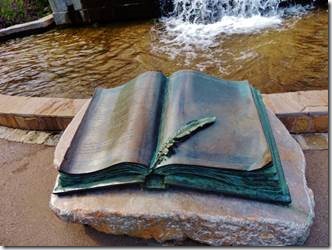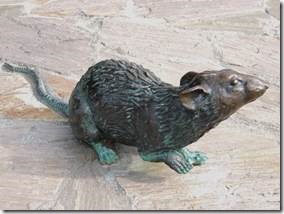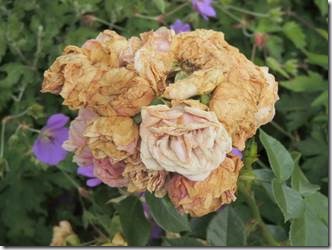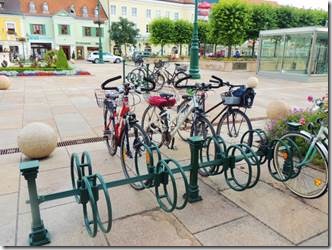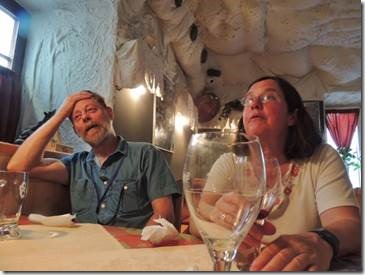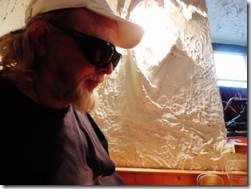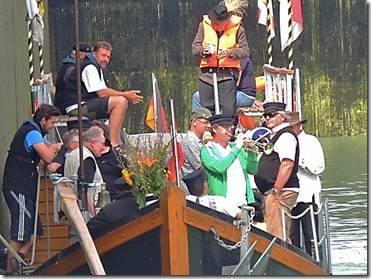Wien Marina, Vienna
Guten Morgen,
We are in what we call Vienna but is really Wien. W is pronounced as V which makes it sound sort of like Vienna. We arrived yesterday at 11:25 am and after getting tied up and official with the Harbor Master, went off to the nearby mall for lunch. Another pizza place oddly enough but they had the best bruschetta on earth. It was thin crispy toasted Italian bread with ricotta and arugula and cherry tomatoes over which I drizzled olive oil. Simple but delicious. The lemonade was sparkling water with lots of real lemon squeezed in and no sugar. Perfect. At some point we’ll try to sample some “Austrian” dishes.
This email is about our quick evening stop in Tulln after a long passage from Grein.
Ru
|
“… This is the start of one of the Danube’s most romantic sections. For 24km, it flows through the Nibelung region, scene of the song saga that inspired Wagner’s operas.” JMP Guide The Danube |
|
The artist Egon Schiele was born in Tulln. We came across this info plaque with only a short bit in English. But it was intriguing. We were only out for a late afternoon stroll and dinner so couldn’t visit the museum dedicated to Schiele. “here you find out where people strolled in the fin de siècle Tulln and were Egon’s father drove the family: why people secretly whispered about them and why the station master was a town dignitary.” When Egon Schiele was 15 years old, his father died from syphilis, and he became a ward of his maternal uncle, Leopold Czihaczec, who became distressed by Schiele’s lack of interest in academic studies, yet recognized his passion and talent for art. http://www.egon-schiele.net/biography.html “The year is 189. A lanky boy is sitting at a window in the Tulln train station painting locomotives and trains. A few years later he will have become the star of Vienna Modernism….Tulln’s most famous native son.” Tulln tourist booklet Kneeling Female in Orange-Red Dress by Egon Schiele, mixed media drawing, 1910. Most of his works are more risqué than I can post here, but I like this one with the simplicity and color. |
|
Statue of Mercury ; we’ve seen many buildings in Germany and Austria painted this yellow “The locally available building materials endowed each city with a predominant color palette still recognizable today. Bologna was known as “The Red City” not merely for its political bias, but for the deep earthen red tones of almost every building in the city. Oxford and nearby Cotswold towns have a pale golden tone from the limestone used in construction. When the structure was felt to lack visual appeal, colored plaster or stucco was applied. The whole Hapsburg Empire was once recognizable through the predominance of its golden yellow buildings, the color favored by Empress Maria Theresa. The selection of this color may have helped to unify the diverse nationalities: Austrian, Hungarian, German, Czech, Slovak, Polish, and Slovenian. According to the color psychologist, Charles A. Riley II, golden yellow is almost universally people’s favorite color and is thought to express “the apex of spirituality, and intuition[1]”. http://www.livablecities.org/ Giant rings outside a jewelry store |
|
These yucca made me homesick; my Bunker Hill St. house in Roanoke had a huge yucca and daylilies. |
|
The Nibelung Saga… The German Nibelungen — with the corresponding Old Norse form Niflung — is the name in Germanic and Norse mythology of the royal family or lineage of the Burgundians who settled in the early 5th century at Worms. Wikipedia The statue depicts Atilla (King Etzel in the poem) receiving his bride Kriemhild, who’s come by boat from Passau. Monument to the Nibelungs which I pretty much know nothing about even after reading the brochure.. http://www.youtube.com/watch?v=GGU1P6lBW6Q is Wagner’s Ride of the Valkyries which is part two of the Nibelung saga. I danced around the house to it when I was a kid. The Stop & Shop grocery store sold 78s of famous classical music which my mother would buy and play for us. And more recently, The sci-fi/western Adventures of Brisco County Jr. which was a short lived but really good show had some characters based on the Valkyries. I really liked that show! |
|
Not sure why the rat and neither is anyone else whose writing I found on the Internet …. “The group of figures to the left compromises two train-bearing princes, Margrave Rudiger, and Kriemhild; the one to the right consists of King Etzel, his brother Bleda and the kings Dietrich von Bern and Gibich. The child is a reference to the progeny of Etzel and Kriemhild. The interlacing water jets in the fountain are meant to symbolize the connection between East and West. The opened book refers to the fact that this epic is handed down in written form. The right-hand page is empty – the future is still an unwritten page. The bronze figures were produced using a hollow casting technique. They are the work of the sculptor Michail Nogin; the fountain was designed by Hans Muhr. The monument was unveiled in the summer of 2005.” “ The poets decision to have Kriemhild and Etzel meet in Tulln shows the significance of the town around 1200. Another factor in the poet’s mind may have been that the border between the East (Hungary) and the West (the German lands) had run through the town 250 years earlier. (The work was written around 1200.” Monument to the Nibelungs brochure Prevailing scholarly theories strongly suggest that the written Nibelungenlied is the work of an anonymous poet from the area of the Danube between Passau and Vienna, dating from about 1180 to 1210, possibly at the court of Wolfger von Erla, the bishop of Passau (in office 1191–1204). Most scholars consider it likely that the author was a man of literary and ecclesiastical education at the bishop’s court, and that the poem’s recipients were the clerics and noblemen at the same court. The "Nibelung’s lament" (Diu Klage), a sort of appendix to the poem proper, mentions a "Meister Konrad" who was charged by a bishop "Pilgrim" of Passau with the copying of the text. This is taken as a reference to Saint Pilgrim, bishop of Passau from 971–991. “The search for the author of the Nibelungenlied in German studies has a long and intense history. Among the names suggested were Konrad von Fußesbrunnen, Bligger von Steinach and Walther von der Vogelweide. None of these hypotheses has wide acceptance, and mainstream scholarship today accepts that the author’s name cannot be established. In 2009, the three main manuscripts of the Nibelungenlied were inscribed in UNESCO’s Memory of the World Register in recognition of their historical significance ” http://en.wikipedia.org/wiki/Nibelungenlied |
|
Beautiful dried roses. The best gardens are those that have flowers which are beautiful when they’re alive but also when they die. Where there are bike paths people ride bikes! |
|
We ate in a pizza joint just across from the Information Office both of which were really good! I had a smallish cheese and spinach pizza with really thin crust. (The last few pieces were great the next morning for a snack with coffee.) The owner asked if we all liked garlic in our food and we said yes. But so far, no restaurant or recipe cooked here on the boat has reached our level of garlic tolerance. Never too much garlic. There were sombreros on the wall for decoration. |
|
While waiting in our final lock before Vienna we were serenaded by this boat or musicians. The lock was better than a music hall and it was so fun to hear them. The man in green is the horn player. |

